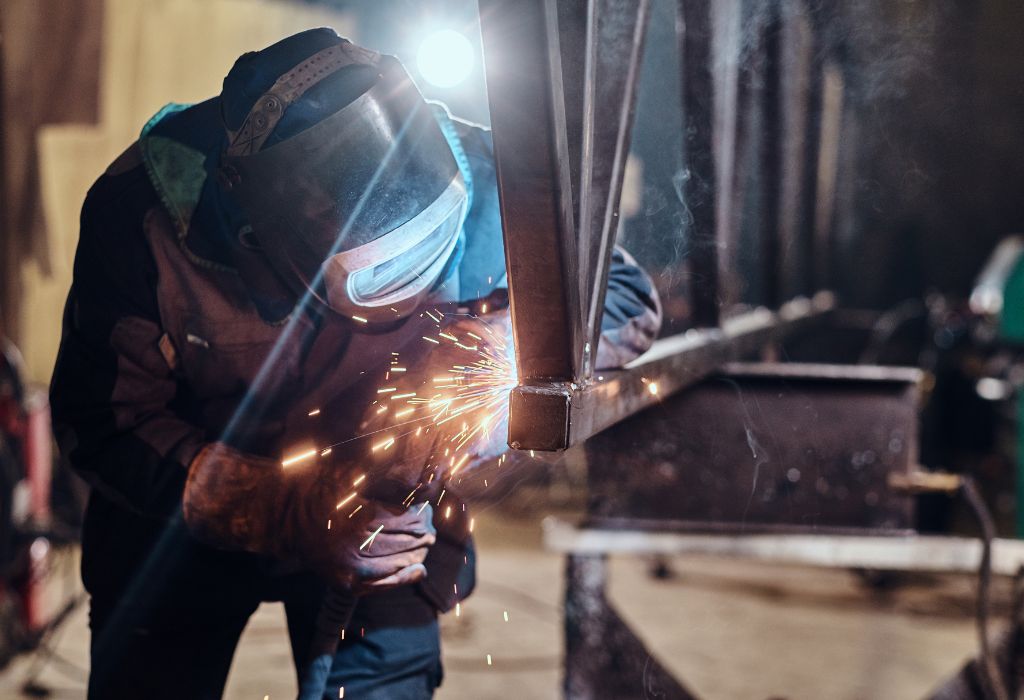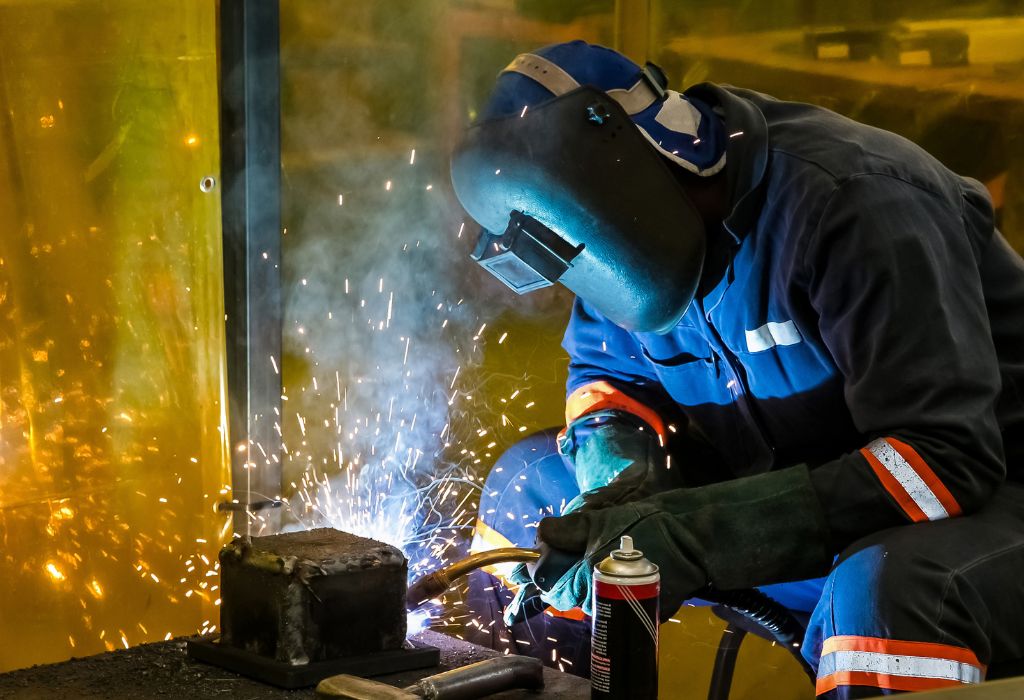A recent trade school graduate walks into their first job interview, welding hood in hand, and wonders: how much does a beginner welder make in 2025?
The answer is not as straightforward as it may seem, since location, industry, and skill level all shape the first paycheck.
Across the United States, entry-level welders often earn between $18 and $25 per hour, averaging around $22–$23 per hour according to job posting data (Indeed / ZipRecruiter).
For a full-time schedule, that equals roughly $40,000 to $48,000 annually before overtime.
In comparison, the median annual wage for all welders was about $51,000 in May 2024, showing that beginners can climb quickly as they gain certifications and experience (BLS).
The need for welders also boosts pay potential. The American Welding Society projects a shortage of about 80,000 welders per year between 2025 and 2029, driven by retirements and increased demand in construction, energy, and manufacturing (AWS).
For those just starting, this shortage translates into more opportunities, faster raises, and higher job security.
Still, pay is not uniform. A beginner in a small fabrication shop may earn less than one who joins a union crew or takes a traveling pipeline job with per diem benefits.
Apprenticeship programs, shift differentials, and overtime can also significantly change total take-home pay.
This guide explores the numbers in detail, from national averages to state differences, industry-specific pay, and the impact of certifications.
By the end, you’ll understand exactly what entry-level welders can expect in 2025 and how to maximize income in the first year.
Quick Answer — How Much Does a Beginner Welder Make in 2025?

For 2025, a beginner welder in the U.S. typically earns between $18 and $25 per hour. This equates to annual earnings of $40,000–$48,000 for a standard workweek.
Job postings show the national average is around $22–$23/hr for entry-level welders (Indeed, ZipRecruiter). Apprenticeships or helper roles may start lower, but overtime and shift differentials often push real income higher.
Compared to the Bureau of Labor Statistics median wage of $51,000 for all welders, beginners are close to the national midpoint and can progress quickly with added skills (BLS).
What’s the average entry-level hourly wage?
About $22–$23/hr across the U.S.
Is apprentice pay lower than “Welder I”?
Yes, apprentices start lower; Welder I roles sit at the bottom tier of full pay scales.
Do beginners get overtime?
Yes, overtime is common and raises weekly income significantly.
Does location change everything?
Absolutely — pay can swing 20–40% higher in high-demand states.
How fast can pay rise?
Often within 6–18 months as skills and certifications increase.
What Drives Entry-Level Welder Pay?
Several factors shape how much a beginner welder earns. The biggest drivers are location, industry, process specialization, and certifications.
Geography matters because cost of living and demand create large pay gaps. Energy states, coastal shipyards, and industrial hubs often pay far more than small towns.
Process skill also plays a role. Beginners trained in TIG or flux-core can command higher wages than those limited to MIG. Certifications like AWS D1.1 give new welders leverage.
Which process pays more for beginners?
TIG and flux-core welders often earn above average.
Union or non-union for starters?
Unions provide wage floors and benefits, but availability varies by state.
Does night shift pay more?
Yes, shift differentials add extra per hour.
Do AWS certs help day one?
Yes, they can raise starting pay by several dollars an hour.
Is travel worth it?
Yes, per-diem jobs often out-earn local work.
National Benchmarks — BLS vs Job Postings
The Bureau of Labor Statistics (BLS) reports that the median annual wage for welders was about $51,000 in 2024. This includes experienced professionals, so it is higher than many true entry-level offers (BLS).
Job boards like Indeed and ZipRecruiter give real-time numbers for beginners. They show national entry-level averages around $22–$23/hr. This aligns with anecdotal reports from trade schools and new hires.
Together, these figures show a path: beginners earn slightly less than the median, but they can reach or exceed it within 1–2 years.
Why do numbers differ by source?
BLS counts all welders; job boards focus on active postings.
Is $51k realistic for year one?
Possible with overtime, but base salaries start lower.
Are posted rates inflated?
Sometimes, but they reflect competitive hiring.
Which metric matters most?
Hourly wage plus overtime and benefits.
Are helper roles included?
Not always; titles vary by employer.
By State and City — Where Beginners Earn the Most
Pay for beginner welders varies dramatically across the U.S. States with strong construction, energy, or shipbuilding sectors typically offer higher wages.
For example, Alaska, California, and Gulf Coast states often report wages above the national average (ZipRecruiter). Meanwhile, Midwestern states may offer lower hourly rates but balance with lower living costs.
Large metro areas like Houston, Los Angeles, and Seattle pay well due to industrial demand. However, rural areas with labor shortages also offer strong wages to attract new welders.
Best states for new welders?
Alaska, California, and Texas are among the highest paying.
Are oilfield roles beginner-friendly?
Some hire helpers, but skill requirements are steep.
Can small towns pay well?
Yes, especially where welders are scarce.
Is relocation worth it early?
Often yes, for faster wage growth.
How to compare offers?
Use cost-of-living calculators alongside hourly rates.
By Industry — Manufacturing vs Construction vs Shipyards vs Energy

Industry choice greatly affects beginner pay. Manufacturing jobs provide steady hours but lower starting wages.
Construction and structural steel jobs often pay more, especially for flux-core welders. Shipyards and aerospace companies pay premiums for TIG and precision work.
Energy and pipeline roles can pay the highest due to travel, per-diem, and safety requirements.
Which industry pays beginners most?
Energy and shipyards often lead.
Do aerospace shops hire beginners?
Yes, if they pass TIG qualification tests.
Is pipeline work open to new welders?
Sometimes, usually as helpers at first.
Does certification matter by industry?
Yes, some industries require specific AWS codes.
Where is overtime common?
Construction and turnaround projects often need extra hours.
By Process — MIG, TIG, Stick, Flux-Core
Process knowledge has a direct impact on entry-level pay. MIG (GMAW) is the most common beginner process, with starting wages near the average.
TIG (GTAW) is harder to learn but offers higher pay in aerospace and precision fabrication. Stick (SMAW) and flux-core (FCAW) are in demand for outdoor and structural work, which often pays more than shop MIG.
Adding multiple processes makes a welder far more marketable and speeds up raises.
Can a MIG-only welder get $25/hr?
Yes, but TIG or flux-core open more doors.
What raises pay fastest?
Adding TIG stainless or FCAW all-position.
Does dual-shield pay more?
Yes, on structural steel projects.
Is multi-process training worth it?
Yes, it leads to faster promotions.
Are stainless or pipe certs valuable?
Yes, they significantly increase wages.
Apprenticeships, Unions, and Certifications
Apprenticeships allow beginners to earn while training. Pay starts lower but rises with each stage of progress.
Unions provide structured pay scales, benefits, and job security. Non-union jobs may pay more initially but vary in benefits.
Certifications such as AWS D1.1 are critical for proving skill and unlocking higher pay levels.
How long from helper to welder I?
Often 6–12 months with consistent training.
Which AWS cert first?
Structural plate (D1.1) is the most common.
Do unions accept beginners?
Yes, through apprenticeship programs.
Are employer tests common?
Yes, many companies require in-house welding tests.
Can certs be earned on the job?
Yes, many employers sponsor testing.
Benefits, Overtime, and Total Compensation
Base pay is only part of the picture. Overtime, shift differentials, and per-diem can significantly raise income.
For example, at $22/hr, 10 hours of weekly overtime at time-and-a-half adds over $17,000 annually. Benefits like health insurance and retirement also boost total compensation.
This means beginners can out-earn posted averages quickly if they work long hours or travel.
How much does overtime add?
It can increase income by 25–40%.
Are per-diem roles beginner-friendly?
Yes, some crews hire entry-level welders with travel pay.
Do benefits offset lower base pay?
Yes, healthcare and retirement add long-term value.
Is piece-rate pay common?
Sometimes in manufacturing shops.
Do employers pay for training time?
Many do, especially during certification testing.
First-Year Roadmap — How to Boost Pay Quickly

The first year sets the stage for a welding career. Consistent attendance, safety, and productivity help secure raises.
Adding one high-value process like TIG or flux-core within six months can raise pay by $3–$5/hr. Relocating to high-demand regions also speeds wage growth.
By year one’s end, beginners can move from $22/hr to $26–$28/hr with the right steps.
Top move for a fast raise?
Add TIG or FCAW all-position skills.
How to negotiate as a beginner?
Leverage certifications and competing offers.
Should you build a portfolio?
Yes, photos of test welds help secure jobs.
Is personal gear worth buying?
Yes, quality hoods and tools boost performance.
When to switch employers?
After proving reliability and gaining certs.
Outlook 2025–2029 — Demand and Wage Pressure
The welding industry faces a significant labor shortage. AWS forecasts a need for 80,000 new welders per year through 2029 (AWS).
Automation will change tasks but not eliminate jobs. Skilled operators, inspectors, and certified welders will remain in high demand.
This shortage should keep wages rising, especially in construction, energy, and precision industries.
Will automation replace beginners?
Not fully; skilled welders will still be needed.
Best niches for job security?
Energy, aerospace, and ship repair.
Will wages rise in 2025–2029?
Yes, especially where shortages are severe.
Is inspection a good career path?
Yes, Certified Welding Inspectors earn more.
Do certs transfer between states?
AWS certifications are widely accepted.
Conclusion
So, how much does a beginner welder make in 2025? On average, $18–$25 per hour, or about $40,000–$48,000 per year, with overtime often boosting earnings higher.
Pay varies by region, industry, and process skills. Beginners who pursue certifications, union apprenticeships, or travel work see faster wage growth.
With the ongoing shortage of welders, now is one of the best times to enter the trade. By gaining new skills and targeting high-demand sectors, beginners can quickly move from starting wages to some of the most secure and rewarding jobs in skilled trades.

I’m Darrell Julian, the founder, lead writer, and hands-on welding enthusiast behind ArcWeldingPro.com. With more than 15 years of real-world welding experience, I created this platform to share what I’ve learned in the field, in the shop, and in the heat of the arc.


